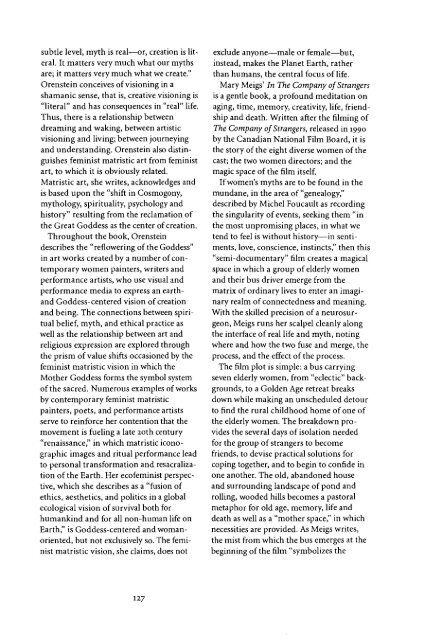To All Appearances A Lady - University of British Columbia
To All Appearances A Lady - University of British Columbia
To All Appearances A Lady - University of British Columbia
You also want an ePaper? Increase the reach of your titles
YUMPU automatically turns print PDFs into web optimized ePapers that Google loves.
subtle level, myth is real—or, creation is literal.<br />
It matters very much what our myths<br />
are; it matters very much what we create."<br />
Orenstein conceives <strong>of</strong> visioning in a<br />
shamanic sense, that is, creative visioning is<br />
"literal" and has consequences in "real" life.<br />
Thus, there is a relationship between<br />
dreaming and waking, between artistic<br />
visioning and living; between journeying<br />
and understanding. Orenstein also distinguishes<br />
feminist matristic art from feminist<br />
art, to which it is obviously related.<br />
Matristic art, she writes, acknowledges and<br />
is based upon the "shift in Cosmogony,<br />
mythology, spirituality, psychology and<br />
history" resulting from the reclamation <strong>of</strong><br />
the Great Goddess as the center <strong>of</strong> creation.<br />
Throughout the book, Orenstein<br />
describes the "reflowering <strong>of</strong> the Goddess"<br />
in art works created by a number <strong>of</strong> contemporary<br />
women painters, writers and<br />
performance artists, who use visual and<br />
performance media to express an earthand<br />
Goddess-centered vision <strong>of</strong> creation<br />
and being. The connections between spiritual<br />
belief, myth, and ethical practice as<br />
well as the relationship between art and<br />
religious expression are explored through<br />
the prism <strong>of</strong> value shifts occasioned by the<br />
feminist matristic vision in which the<br />
Mother Goddess forms the symbol system<br />
<strong>of</strong> the sacred. Numerous examples <strong>of</strong> works<br />
by contemporary feminist matristic<br />
painters, poets, and performance artists<br />
serve to reinforce her contention that the<br />
movement is fueling a late 20th century<br />
"renaissance," in which matristic iconographie<br />
images and ritual performance lead<br />
to personal transformation and resacralization<br />
<strong>of</strong> the Earth. Her ec<strong>of</strong>eminist perspective,<br />
which she describes as a "fusion <strong>of</strong><br />
ethics, aesthetics, and politics in a global<br />
ecological vision <strong>of</strong> survival both for<br />
humankind and for all non-human life on<br />
Earth," is Goddess-centered and womanoriented,<br />
but not exclusively so. The feminist<br />
matristic vision, she claims, does not<br />
exclude anyone—male or female—but,<br />
instead, makes the Planet Earth, rather<br />
than humans, the central focus <strong>of</strong> life.<br />
Mary Meigs' In The Company <strong>of</strong> Strangers<br />
is a gentle book, a pr<strong>of</strong>ound meditation on<br />
aging, time, memory, creativity, life, friendship<br />
and death. Written after the filming <strong>of</strong><br />
The Company <strong>of</strong> Strangers, released in 1990<br />
by the Canadian National Film Board, it is<br />
the story <strong>of</strong> the eight diverse women <strong>of</strong> the<br />
cast; the two women directors; and the<br />
magic space <strong>of</strong> the film itself.<br />
If women's myths are to be found in the<br />
mundane, in the area <strong>of</strong> "genealogy,"<br />
described by Michel Foucault as recording<br />
the singularity <strong>of</strong> events, seeking them "in<br />
the most unpromising places, in what we<br />
tend to feel is without history—in sentiments,<br />
love, conscience, instincts," then this<br />
"semi-documentary" film creates a magical<br />
space in which a group <strong>of</strong> elderly women<br />
and their bus driver emerge from the<br />
matrix <strong>of</strong> ordinary lives to enter an imaginary<br />
realm <strong>of</strong> connectedness and meaning.<br />
With the skilled precision <strong>of</strong> a neurosurgeon,<br />
Meigs runs her scalpel cleanly along<br />
the interface <strong>of</strong> real life and myth, noting<br />
where and how the two fuse and merge, the<br />
process, and the effect <strong>of</strong> the process.<br />
The film plot is simple: a bus carrying<br />
seven elderly women, from "eclectic" backgrounds,<br />
to a Golden Age retreat breaks<br />
down while making an unscheduled detour<br />
to find the rural childhood home <strong>of</strong> one <strong>of</strong><br />
the elderly women. The breakdown provides<br />
the several days <strong>of</strong> isolation needed<br />
for the group <strong>of</strong> strangers to become<br />
friends, to devise practical solutions for<br />
coping together, and to begin to confide in<br />
one another. The old, abandoned house<br />
and surrounding landscape <strong>of</strong> pond and<br />
rolling, wooded hills becomes a pastoral<br />
metaphor for old age, memory, life and<br />
death as well as a "mother space," in which<br />
necessities are provided. As Meigs writes,<br />
the mist from which the bus emerges at the<br />
beginning <strong>of</strong> the film "symbolizes the<br />
127

















